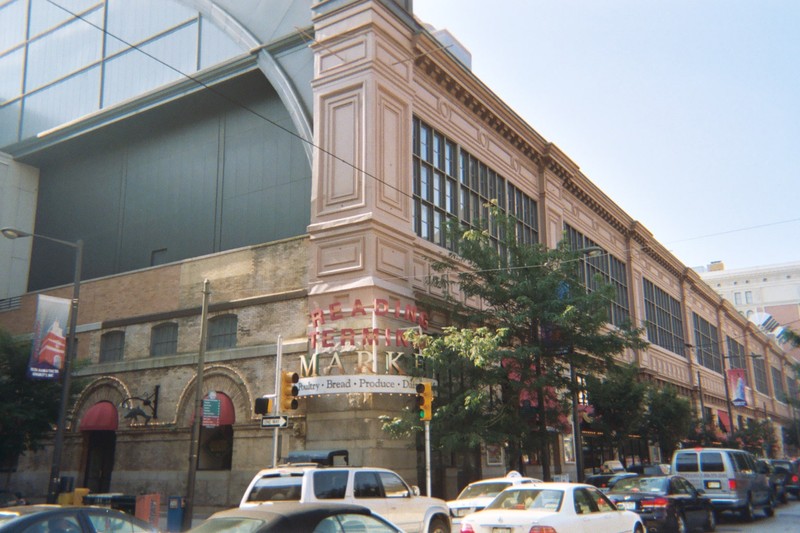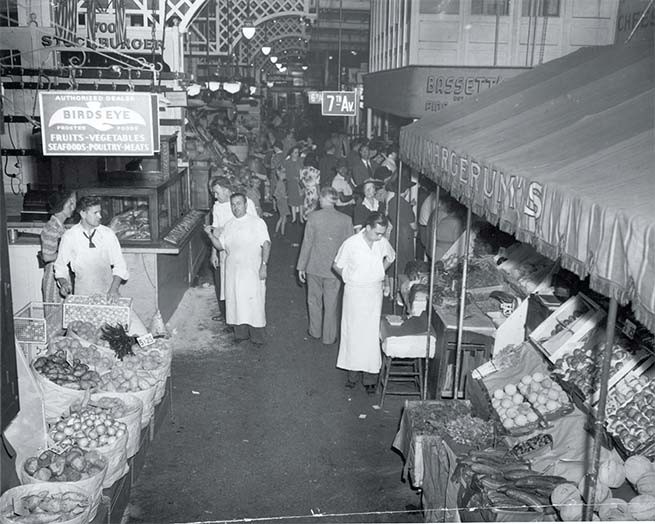Reading Terminal Market
Introduction
Text-to-speech Audio
Images
A view of the Market today.

“Trains and Turnips,” Reading Terminal Market in 1942.

Meat rationing sends lunchtime customers to William L. Evans Seafood Specialists in 1947.

Interior of Reading Terminal Market today.

Backstory and Context
Text-to-speech Audio
In the 1680’s, open-air markets flourished up and down High Street (later renamed Market Street in 1858) with a mile of fisherman and farmers from southern New Jersey selling their products. As the market grew, the local government decided to build a formal market head house from which to organize vendors. On Wednesdays and Saturdays (market days), chains were put up around the market to protect shoppers from carriages and carts. However, the public began viewing the market as dirty and unhygienic and complained about the traffic hazard it created. In 1859, city officials closed the market, which prompted the opening of two indoor markets: Franklin Market and Farmers' Market. These markets would one day combine to form Reading Terminal Market.
A year after these markets consolidated to form Reading Terminal Market, the Industrial Revolution brought new train tracks and terminals to Philadelphia. The Philadelphia and Reading Railroad Company combined its four Philadelphia terminals into one big terminal, Reading Station, which opened in 1893 and was located above the market: elevated rails ran upwards to reach the train shed platform built in the air. The area underneath the market housed a large refrigerator that was more expensive to maintain and had a larger staff than the market itself. However, the refrigerator allowed merchants to keep seasonal products in stock year-round and parts of it were also leased to other restaurants and vendors in the area.
Within the first year of its opening, Reading Terminal Market held 380 merchants and remained at nearly full occupancy for the next 60 years. The Depression of the 1930’s brought pressure for merchants to join labor unions and the introduction of supermarkets- both of which hurt the market’s business, but did not cause it to shut down or suffer enormously. During the 1940s, U.S. involvement in World War II actually encouraged business at the market as food shortages increased the demand for merchant’s goods. On May 9, 1946 Reading Terminal Market recorded its largest crowd ever when 12,000 people came to buy meat products unavailable almost everywhere else. However, the growing prominence of supermarkets soon brought a new source of competition for the market.
In 1971 the railroad company running above the market declared bankruptcy and retracted its funding of the market. Slowly the price of renting space in the market increased, the refrigerator space below closed, and by 1979 the market was only 20% occupied. However, in 1980 the Reading Company emerged from bankruptcy and began investing in the market once again by revitalizing the space, adding vendors, and ultimately transforming it into a major tourist attraction. In 1984 the train terminal moved from above the market to below it and continued as SEPTA Regional Rails’ Jefferson Station (formerly Market East). Today, Reading Terminal Market is listed as one of the top tourist destinations in Philadelphia and is open every day of the week.
Sources
"History of the Market." Reading Terminal Market. Accessed October 28, 2017. http://www.readingterminalmarket.org/about-the-market/history.
O'Neil, David. Reading Terminal Market: An Illustrated History. Philadelphia: Camino Books, 2004.
"Reading Terminal Market." Visit Philadelphia. Accessed October 28, 2017. http://www.visitphilly.com/restaurants-dining/philadelphia/reading-terminal-market/.
Weatherill, Mary. "Reading Terminal Market." Phila Place. Accessed October 28, 2017. http://www.philaplace.org/story/1369/.
